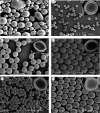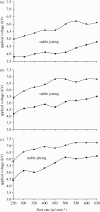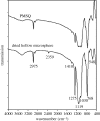Controlling the thickness of hollow polymeric microspheres prepared by electrohydrodynamic atomization
- PMID: 20519216
- PMCID: PMC2943886
- DOI: 10.1098/rsif.2010.0092.focus
Controlling the thickness of hollow polymeric microspheres prepared by electrohydrodynamic atomization
Abstract
In this study, the ability to control the shell thickness of hollow polymeric microspheres prepared using electrohydrodynamic processing at ambient temperature was investigated. Polymethylsilsesquioxane (PMSQ) was used as a model material for the microsphere shell encapsulating a core of liquid perfluorohexane (PFH). The microspheres were characterized by Fourier transform infrared spectroscopy and optical and electron microscopy, and the effects of the processing parameters (flow-rate ratio, polymer concentration and applied voltage) on the mean microsphere diameter (D) and shell thickness (t) were determined. It was found that the mean diameters of the hollow microspheres could be controlled in the range from 310 to 1000 nm while the corresponding mean shell thickness varied from 40 to 95 nm. The results indicate that the ratio D : t varied with polymer concentration, with the largest value of approximately 10 achieved with a solution containing 18 wt% of the polymer, while the smallest value (6.6) was obtained at 36 wt%. For polymer concentrations above 63 wt%, hollow microspheres could not be generated, but instead PMSQ fibres encapsulating PFH liquid were obtained.
Figures










Similar articles
-
A new method for the preparation of monoporous hollow microspheres.Langmuir. 2010 Apr 6;26(7):5115-21. doi: 10.1021/la903592s. Langmuir. 2010. PMID: 20095539
-
Electrohydrodynamic preparation of polymeric drug-carrier particles: mapping of the process.Int J Pharm. 2011 Feb 14;404(1-2):110-5. doi: 10.1016/j.ijpharm.2010.11.014. Epub 2010 Nov 17. Int J Pharm. 2011. PMID: 21093562
-
Electrohydrodynamic atomization for biodegradable polymeric particle production.J Colloid Interface Sci. 2006 Oct 1;302(1):103-12. doi: 10.1016/j.jcis.2006.06.037. Epub 2006 Jun 29. J Colloid Interface Sci. 2006. PMID: 16842810
-
Coaxial electrohydrodynamic atomization process for production of polymeric composite microspheres.Chem Eng Sci. 2013 Dec 18;104:10.1016/j.ces.2013.09.020. doi: 10.1016/j.ces.2013.09.020. Chem Eng Sci. 2013. PMID: 24347672 Free PMC article.
-
Ultrasound-assisted encapsulation of Pandan (Pandanus amaryllifolius) extract.Ultrason Sonochem. 2021 Nov;79:105793. doi: 10.1016/j.ultsonch.2021.105793. Epub 2021 Oct 15. Ultrason Sonochem. 2021. PMID: 34673338 Free PMC article. Review.
Cited by
-
Coaxial electrospray of microparticles and nanoparticles for biomedical applications.Expert Rev Med Devices. 2012 Nov;9(6):595-612. doi: 10.1586/erd.12.58. Expert Rev Med Devices. 2012. PMID: 23249155 Free PMC article. Review.
-
The influence of drug solubility and sampling frequency on metformin and glibenclamide release from double-layered particles: experimental analysis and mathematical modelling.J R Soc Interface. 2019 Jun 28;16(155):20190237. doi: 10.1098/rsif.2019.0237. Epub 2019 Jun 26. J R Soc Interface. 2019. PMID: 31238838 Free PMC article.
-
An encapsulated drug delivery system for recalcitrant urinary tract infection.J R Soc Interface. 2013 Sep 25;10(89):20130747. doi: 10.1098/rsif.2013.0747. Print 2013 Dec 6. J R Soc Interface. 2013. PMID: 24068180 Free PMC article.
-
Alginate hydrogel beads embedded with drug-bearing polycaprolactone microspheres for sustained release of paclobutrazol.Sci Rep. 2021 May 25;11(1):10877. doi: 10.1038/s41598-021-90338-9. Sci Rep. 2021. PMID: 34035364 Free PMC article.
-
Scaling the heights--challenges in medical materials. Introduction.J R Soc Interface. 2010 Aug 6;7 Suppl 4(Suppl 4):S377-8. doi: 10.1098/rsif.2010.0259.focus. Epub 2010 Jun 2. J R Soc Interface. 2010. PMID: 20519211 Free PMC article. No abstract available.
References
-
- Bocanegra R., Galán D., Márquez M., Loscertales I., Barrero A. 2005. Multiple electrosprays emitted from an array of holes. J. Aerosol Sci. 36, 1387–1399. (10.1016/j.jaerosci.2005.04.003) - DOI
-
- Bogart K. H. A., Dalleska N. F., Bogart G. R., Fisher E. R. 1995. Plasma enhanced chemical vapor deposition of SiO2 using novel alkoxysilane precursors. J. Vac. Sci. Technol. A Vac. Surf. Films 13, 476–480. (10.1116/1.579382) - DOI
Publication types
MeSH terms
Substances
LinkOut - more resources
Full Text Sources
Other Literature Sources

